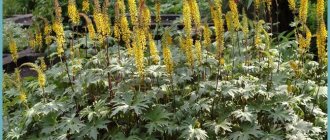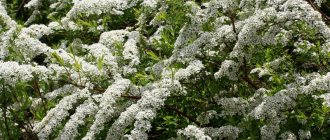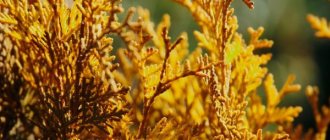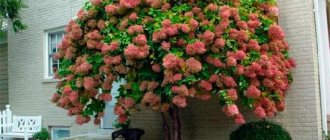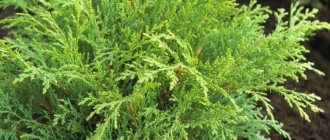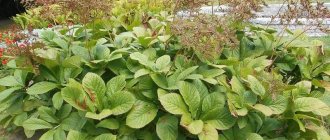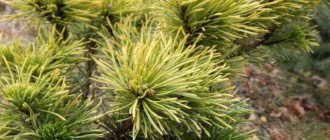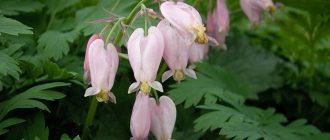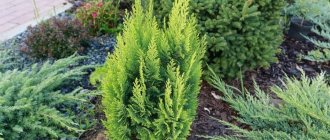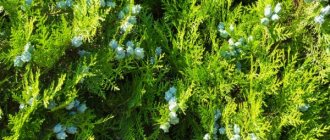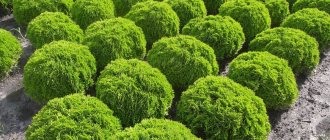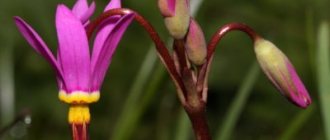Spruce Nidiformis is an elegant landscape design. Description, planting, care
Landscaping your own plot is a task that its owners take very seriously. Having long ago abandoned planting exclusively fruit and berry trees, gardeners turned their close attention to evergreens. They have a huge advantage over others because they decorate the garden even “out of season.” A very interesting representative of conifers is the Nidiformis spruce, which has become popular in recent years.
Funny Christmas tree
First of all, the plant is interesting because it is a shrub, not a tree, and has a bizarre, unusual shape: in young years, the shoots bend upward, rounding off the outlines. For this reason, the Nidiformis spruce is often called a nest tree.
Over the years, this tendency is lost, and the bush acquires tiered symmetry, while maintaining a cushion shape.
The color of the needles is striking, bright green; It is curious that the needles are needle-shaped, but not prickly. The height is most often half the diameter of the crown, the average height is about 70 cm, although some specimens can reach a meter. Nidiformis spruce grows slowly, but the average lifespan is about 250 years.
The main characteristics are shade tolerance and frost resistance. However, you should not abuse this last quality: at prolonged low temperatures, the bush still freezes, so it is recommended for areas where in winter the temperature rarely drops below -20. And shade tolerance is a relative question: if there is little light, the Nidiformis spruce loses its bright color, gradually turning yellow and “blurring” in shape.
Planting correctly
If you choose the Nidiformis spruce, plant it according to the general rules for all varieties of spruce. They are:
- The best time for planting is the end of April. An alternative could be the end of August.
- The planting hole is dug in advance. Its upper diameter should be between 40 and 60 cm, the lower – from 30 to 40, the depth – about half a meter.
- The bottom is lined with drainage (broken brick or crushed stone) to a height of 15-20 cm.
- The removed soil is mixed with peat, sand and humus; it is advisable to also add nitroammophoska.
- When planting, you should strive to keep the lump intact. It is necessary to compact the soil around the seedling without excessive zeal.
The planted Nidiformis spruce is well watered: this will ensure uniform subsidence of the earth in the tree trunk circle. When planting in autumn, watering is stopped until spring; in April, they become weekly.
Spruce Nidiformis: care and attention
Like most conifers, the nest tree is quite undemanding. It does not need winter cover: even a serious snow blockage does not break the branches, it tolerates frosts well. But for the first two years it will have to be protected from spring burns by creating shading.
During dry periods, Nidiformis spruce needs to be watered, but wisely: stagnation of water will destroy the plant. Survival and growth are greatly stimulated by mulching the area around the trunk with mown grass or bark. In addition to retaining moisture without excess moisture, mulch prevents soil compaction, which spruce does not tolerate well.
Description of spruce
Nidiformis comes from Germany, the variety was developed relatively recently. Compared to other types of fir trees, it has several distinctive features:
- Short stature. The tree grows no more than one meter in height.
- Strong branching.
- Short needles. The needles are up to one centimeter long, thick.
- Globular shape of the tree. The mature tree becomes perfectly round.
- Only mature plants develop cones.
Norway spruce nidiformis grows slowly: in 3 years it can only grow a few centimeters . The color of the needles is dark green, young shoots are light green. Spruce grows slowly and tolerates frost well , making the species very popular among gardeners.
Like all spruces, it is susceptible to sunburn , so you should not plant it in a sunny area, or you need to shade the plant until it gets stronger. Three years after planting, the Christmas tree will no longer be so exposed to the sun.
Description of the species
Low-growing spruces are a subspecies of conifers. Unlike their counterparts, which reach a height of 40 m, dwarf varieties grow no higher than 8 m, and the “height” of some of them, even in adulthood, does not exceed 35 cm. In scientific circles, they are officially classified not by height, but by the color of the needles . An unofficial, conventional classification, which is used in practice (among landscape designers and amateur gardeners) often divides varieties into 4 subspecies:
- short - from 3 to 8 m,
- dwarf – 40 cm-1 m,
- mini spruce – 8-30 cm,
- micro – up to 3 cm.
There is another unofficial type of classification of low-growing spruce trees used by designers and gardeners.
When choosing varieties for the garden, they use the terms “ordinary,” “gray,” and “prickly.” The subspecies can be recognized by its growth rate. During the growing season, representatives of different varieties give growth from 2 to 15 cm. Before giving preference to one or another variety, you need to study its characteristics in order to select a tree of “neighbors” and be able to maintain the landscape in a certain style.
Related article:
Which junipers have blue needles
Choosing a landing site
Since this shrub quickly grows in width, it requires a large space. For one Christmas tree you will need a plot of land three meters in diameter. The tree grows for a long time, so in the first years, while there is free space nearby, you can plant annual plants there.
Read also: Perennial Sidalcea: planting and care, winter hardiness and description
The soil for planting must be fertile and acidic . Drainage and good regular watering are required. A partially shaded area would be an excellent place to plant. To prevent the soil around the tree from compacting, it should be planted away from paths.
There is no need to trample the ground around the spruce; on the contrary, it is recommended to loosen it. Loosening should be done very carefully, since the root system of the spruce is high and there is a risk of damaging it.
It is better to choose a place away from groundwater, since if moisture stagnates, the tree may die. If there is no other place, then you must pour drainage made of crushed stone or broken clay bricks at the bottom of the planting hole.
Planting seedlings
Planting this variety of spruce is completely no different from the method of planting other varieties of fir trees. Very small trees are planted with a clod of earth so as not to damage the root system.
The planting hole must be at least fifty centimeters in diameter and up to a meter deep. If a drainage layer is required, it should be twenty centimeters. Since the root system of Nidiformis is located on top, there is no need to dig a hole that is too deep.
A layer of sand should be poured on top of the drainage layer in order to avoid the accumulation and retention of moisture in the soil. The soil with which the plant will be covered must be fertilized. For this you can use peat, sand, black soil and pine sawdust.
To get a beautiful tree of the correct shape, it is purchased from nurseries or trusted sellers. It is better to buy a plant in a pot so that you can replant it with a lump of earth. Christmas trees are often sold already in fertile, fertilized soil. It is recommended to ask the seller about the composition of the soil in the pot. If fertilizers are not introduced into the ground, then nitroammophos can be poured into the planting hole before planting.
After the planting hole is prepared, you need to:
A small Nidiformis spruce needs about one bucket of water. As the tree matures, the volume of water increases. In the summer, watering should be regular and plentiful, but you must ensure that the moisture does not stagnate. A plant up to one meter requires one bucket of water, above one meter - two buckets.
In the first seven days after transplantation, the plant must be fed with a stimulant. In the first year, be sure to shade the plant from direct sunlight. In order for the plant to wake up faster from winter frosts, it can be watered with warm water starting in March.
Watering
A small Nidiformis spruce needs about one bucket of water. As the tree matures, the volume of water increases. In the summer, watering should be regular and plentiful, but you must ensure that the moisture does not stagnate. A plant up to one meter requires one bucket of water, above one meter - two buckets.
In the first seven days after transplantation, the plant must be fed with a stimulant. In the first year, be sure to shade the plant from direct sunlight. In order for the plant to wake up faster from winter frosts, it can be watered with warm water starting in March.
Spruce "Nidiformis": planting and caring for cushion spruce, decoration in the landscape
If you are looking for an unusual and beautiful shrub for your site, you should definitely pay attention to the common spruce “Nidiformis”. This unpretentious and incredibly beautiful plant will easily become a highlight in any landscape design. We invite you to take a closer look at this dwarf Christmas tree and, perhaps, join its many fans.
Spruce "Nidiformis" is the result of fruitful breeding work of German scientists. It appeared in Germany in 1904. The dwarf Christmas tree has very compact dimensions: its height does not exceed 120 cm, and its crown diameter is 2.5 m.
The shape of this tree is cushion-shaped, and it itself is very fluffy and not at all prickly. The branches are arranged fan-shaped on it. The length of the soft needles varies between 6-10 mm. And the spruce can be painted bright or dark green.
Naturally, the spring color scheme is slightly different from the rest of the growing season, because at this time even evergreen plants are distinguished by their juiciness and richness of color, due to the appearance of new shoots. So in the spring, “Nidiformis” acquires a light green hue due to young shoots.
Read also: How to grow spirea Vangutta in the garden: features of planting and caring for shrubs
4-5 years after planting, the dwarf spruce begins to bear fruit; its fruits are cones 10-15 cm in length and 3-4 cm in diameter. At first they are colored light green, and when ripe they turn brown. This beauty is a long-lived plant and can decorate the garden for 250 years.
Description of dwarf varieties
Russians do not need to choose a variety of low-growing spruce or dwarf spruce species for climatic conditions. Their habitat, like other conifers, is northern and middle latitudes; they tolerate both heat and frost well. But for some of them it is necessary to create certain conditions.
The most famous and common varieties:
- Belobok (Bialibok) - refers to the short ones. This spruce slows down its growth, reaching 3 m. The crown is compact, in the form of a hemisphere, symmetrical or asymmetrical cone. The needles have an original color - blue, with a slight silver tint, quite hard, even prickly, several cm long. In the spring, the tree produces young shoots of a delicate yellow-cream hue, which makes it unusually beautiful. By the end of May, cones up to 5 cm long appear on it.
- Daisy White (Dejzi Uajt) is a dwarf cone-shaped spruce, no more than 1 m high even 10 years after planting. Bright, juicy green, with a pronounced shine, the needles grow up to 2 cm. Freshly grown branches differ from the main ones in color - they are green, with a yellow tint. Light brown cones add aesthetic appeal to the tree from May to August. The variety requires virtually no care, but does not tolerate waterlogged soil. Young plants especially need good drainage.
- Konica (Conica) is a low-growing (up to 3 m) spruce with a fairly voluminous crown (up to 2 m in diameter). The annual growth is no more than 10 cm. The crown is formed by light green, soft needles. The shape of the tree corresponds to the name of the variety - a classic cone. For a garden, this is the best option - a fragrant spruce will become a bright accent next to the rock garden, terrace, decorate the entrance to the yard, and can be used to distinguish zones on the site.
Related article:
Low spruce trees for the garden
- Lucky Strike is a dwarf, slow-growing spruce. The average height of the variety is 1 m, however, there are cases when the tree stretches up to 2 m. The variety is similar in visual characteristics to Konika, but there are also differences. Lucky Strike prefers illuminated areas; it tolerates the winter well in a natural or artificially created snowdrift formed in the root zone. In early spring, the snow is scattered, leaving a cover 10-15 cm thick.
- Sanders Blue is a representative of the dwarf subspecies (up to 1 m). During the year it extends no more than 7 cm. The crown is conical, very dense, formed by needles with a bluish tint. The variety is resistant to spring burns and loves sunny areas with minimal shading. In dry summers, moderate watering is recommended. Soil requirements - good drainage, availability of nutrients. It does not require fertilizing due to its well-developed root system.
Related article:
What to do if the thuja turns red after winter
Most varieties are characterized by needles burning out under the influence of ultraviolet radiation. Don’t be alarmed when the shade changes, the needles become lighter and turn yellow. Low-growing spruce trees rarely shed their needles, and if this happens, they quickly recover.
Growing
The most important thing is that planting and growing the Nidiformis spruce is quite simple, and even a novice gardener can do it. Experts recommend planting dwarf spruce in spring or autumn, but winter planting is also allowed.
Young plants (2-3 years old) are best replanted together with a clod of earth, in which a certain microclimate has already formed.
Video: how to plant a coniferous plant correctly
Coniferous shrubs are best planted in a nutritious, moderately alkaline substrate. Priority is given to clayey and sandy-humus soils. The soil must certainly be well drained, since this plant does not tolerate stagnant moisture.
Location
When planting spruce "Nidiformis" you must take into account that the shrub will grow in width and after 3-4 years its diameter will be about 3 m, therefore, there must be enough space in the area where it will grow.
Young plants do not tolerate open sunlight well, burns may appear on the needles, so the trees need to be shaded. With age, this feature disappears, and the presence of a sufficient amount of light only increases the decorative value of the shrub.
The plant does not require protection from the wind, so it can be planted in open areas.
When it comes to moisture, this plant is considered quite capricious; it does not tolerate both excess and deficiency. You should be especially careful about watering young “Nidiformis”; it is recommended to water them once every 7 days. In very hot and dry weather, the procedure should be carried out 2 times a week. In hot summers, adult plants are watered once every 10-14 days.
When planting, be sure to add 100-150 g of nitroammophoska to the soil. Then the spruce is fed 1-2 times per season with special fertilizers for conifers. Under no circumstances should you use manure, urea and humus; such fertilizing can destroy the Nidiformis spruce.
Dwarf spruce needs regular sanitary pruning, that is, in late May - early June, when sap flow is not so active, it is necessary to remove dried and damaged branches.
Caring for a dwarf spruce is not difficult; in order to do it efficiently, you need to adhere to a few simple rules, namely:
Reproduction
Christmas trees are propagated by cuttings, carried out in April-May. Using a sharp knife or pruning shears, cut branches about 10 cm long from the middle part of the plant. The substrate is made up with the addition of peat and fertilizers for conifers. Before planting, carefully remove the needles and soak in the Kornevin solution for a day. The cuttings are deepened by 5-6 cm, watered and covered with film. Within 3-4 months, the cuttings should take root; until this time they require watering, spraying and ventilation.
Diseases and pests
Very often, dwarf spruce trees "Nidiformis" are affected by spider mites, spruce budworm and spruce-leaved hermes; fungicides and insecticides are used to combat them.
One of the common ailments of this plant is Schutte disease. The fungal disease most often affects young spruce trees. Symptoms are manifested by a change in color and loss of needles. Christmas trees are treated with drugs that contain sulfur or copper, for example, Bordeaux mixture.
This fungicide can also be used for preventive purposes; for this it is necessary to spray the needles in spring and autumn with a weak solution of the drug. To prevent dwarf spruce from getting sick, it is very important to carry out sanitary pruning of the plant in a timely manner and ensure that excess moisture does not accumulate in the soil, which is detrimental to this shrub.
Features of care
In order for the Nidiformis spruce to grow healthy, the plantings must be properly cared for. The main procedures for growing are watering and fertilizing. Regular pruning is also necessary for the plant to fully perform its decorative functions. It is equally important to know how to deal with diseases and parasites that can affect the crop.
Did you know? The oldest spruce in the world grows in the Swedish Fulufjallet National Park. The age of the tree is about 10 thousand years.
Watering and fertilizing
For spruce to grow, it needs to be moistened regularly. Spruce trees older than one year are moistened every 1–1.5 weeks. 1 bucket of water is poured under the tree per watering.
In the first year, plants are watered according to the following scheme:
- in spring and autumn - every 7 days;
- in summer - every 3 days.
The Nidiformis variety is responsive to moderate fertilizing. Immediately after planting, apply 100–150 g of nitroammophoska under the spruce. The plant is then fertilized annually in early spring.
For feeding, use products developed for coniferous plants, according to the instructions, for example:
- Agrecol - 20–30 g for wood;
- Arvi Fertis - 10–25 g for wood.
Important! Avoid nitrogen-rich fertilizers such as ammonium nitrate or fresh manure. If the plants are oversaturated with nitrogenous substances, they will grow and cease to look aesthetically attractive.
Trimming
At the end of spring - beginning of summer, sanitary pruning is carried out. To do this, the plant is inspected and dry and broken branches are removed. In gardening practice, it is customary to lubricate the cut areas with garden varnish, but this does not apply to spruce trees - coniferous trees secrete resin, which acts as a natural antiseptic.
Nidiformis spruces are also pruned for decorative purposes. Formative pruning is carried out for landscape design. Often trees get rid of lateral shoots that spoil the appearance of the plant.
We recommend reading about growing spruce from cone seeds.
Disease and pest control
Diseases and pests can disrupt the viability of Nidiformis spruce. The most common is Schutte's disease . This is a fungal infection that causes the needles to dry out and change color to brown. For prevention, trees are sprayed in October and March with a 1% solution of Bordeaux mixture. At the first symptoms, the affected branches need to be cut out. As a treatment, a 0.2% solution of “Fundazol” is used (single spraying).
Among the pests that are dangerous to crops are:
- spruce-larch Hermes;
- spruce sawfly.
Parasites can be removed with insecticides, for example, the drug "Aktara". 8 g of concentrate is diluted in 10 liters of water. The amount received is enough to process 10 m² of plantings. The period of action of the solution is 2–3 weeks.
Application
The range of applications for dwarf spruce "Nidiformis" is incredibly wide. It is beautiful in both single and group plantings. It is often used to create hedges. At the same time, Christmas trees can be planted both in open ground and in containers, which is very convenient for small areas.
Dwarf spruce goes well with other conifers. It can be used to create a variety of compositions; it is ideal for rock gardens and decorating rocky hills.
How to plant Nidiformis spruce?
First, choose an area with proper lighting. This is where things can get tricky. The fact is that if a seedling is grown in a closed nursery, then bright light will become stressful for it. But, on the other hand, without proper lighting in the future, the needles will lose their bright colors. The problem can be solved with the help of shelter hoods. Cover the young Christmas tree with them during the active sun.
Now let's talk directly about landing. An adult bush is absolutely indifferent to the composition and acidity of the soil. The same cannot be said about a young seedling. How to avoid problems with survival? Very simple!
- Find out from the seller the characteristics of the soil in the container.
- Choose a similar substrate.
- Dig a hole 3 times the size of the root ball.
- Place the seedling in the center so that the root collar is level with the ground surface.
- Fill the hole with the prepared substrate and compact it lightly.
- Cover the tree trunk area with bark and needles. But leave a circle with a diameter of 10 cm near the trunk open. This will protect the trunk from rotting.
Advice! If you plant several bushes at once, maintain a distance between holes of at least 2.5 meters.
Norway spruce Picea abies Nidiformis (nidiformis)
Spruce nidiformis is a beautiful coniferous ornamental plant. Due to its compact size, it is also called “dwarf” and is not even considered a tree. Unpretentious, evergreen, it is very popular among gardeners and landscape designers. The original spherical shape fits perfectly into any garden landscape composition or becomes its highlight. Proper care of the plant will allow you to calmly enjoy the comfort that this Christmas tree creates around you.
Read also: Grandiflora flax: planting and care
Variety of decorative forms
There are more than 20 types of spruce trees in modern parks and gardens. The main thing when choosing the type of conifer is the configuration of its crown and the size of the plant in adulthood.
In landscape design, 3 types of spruce trees are most widespread:
- Ordinary - a typical species represented by more than 50 garden forms. Low-growing forms created on its basis reach a height of 1.2 m, and medium-sized ones reach 3 or more meters. A wide palette of colors of needles, starting from golden and ending with rich green, on branches collected in pyramidal or cushion-shaped crowns, makes conifers of this species welcome guests in garden plots.
- Prickly - more than 70 varieties are represented in the culture. Most of them are medium- and tall-growing trees up to 40 meters high with a beautiful cone-shaped crown. Although there are also dwarf forms up to 2 m high. The needles are very prickly: hence the name of the species. It can be bluish-white, steel-blue, silver and bluish-green.
- Gray - has more than 20 decorative forms. The species got its name due to the ash-gray color of the bark and the bluish tint of the needles. The dwarf forms of this species have a spherical and nest-shaped crown, while the tall ones have a cone-shaped crown. The color palette of needles is quite wide, starting from yellowish-golden and gray-blue and ending with bright green.
Spruces, like any plants, are divided into three groups: dwarf, medium- and tall. When landscaping garden plots, the most popular are dwarf and medium-sized representatives of conifers.
Among the variety of coniferous ornamental plants in landscape design, creeping and dwarf varieties are especially popular
Dwarf varieties
Low-growing forms include plants, the size of which in adulthood is several times smaller in comparison with the original maternal species. For example, in natural conditions, the common spruce, called Picea abies, is a 50-meter beauty with a neatly decorated crown, the width of which reaches 8-10 meters.
The decorative form of this tall conifer, known as Picea abies “Nidiformis” or “cushion spruce,” reaches no more than two meters in height with a crown width of 2-3 meters.
The main advantage of dwarf forms of conifers is the minimal annual growth of young shoots, which in most cases is limited to 10-15 cm
Among modern varieties created on the basis of Norway spruce, the most decorative ones are conifers, the crowns of which have a nest-like or spherical shape.
The miniature shrub Picea abies “Nidiformis” is perfect for forming low borders and decorating rocky gardens.
Dwarf spruce “Nidiformis” reaches a height of only 40 cm in adulthood, forming a spreading crown with a diameter of up to one meter
The fan-shaped thin graceful shoots of “Nidiformis” are decorated with soft and short needles of a delicate emerald shade.
“Little Gems” is no less attractive. The shoots extending from the middle of the crown, framed by dark green thin needles, form a neat hemispherical “cushion”. It looks especially interesting in the form of a standard form, planted in a floor container or flowerpot.
The branches of the miniature beauty Picea abies “Little Gem” are covered with soft short needles of a rich dark green hue.
Picea abies “Will's Zwerg” has a beautiful narrow-conical dense crown shape. The plant is interesting due to the soft green tint of young needles covering the milky shoots, which contrasts favorably against the background of the dark green of old needles. The evergreen shrub is well suited for small home gardens.
Spruce “Will's Zwerg” looks interesting in group compositions and as a solitaire when arranging gardens with a small area
The selectively bred “Glauca Globosa” is famous for its extraordinary decorativeness. The dwarf plant does not have a clearly defined trunk. Its spreading branches, studded with millions of thin needles of an elegant silver-blue hue, form a beautiful spherical crown. The cones that form on the branches, reminiscent of New Year's decorations, give the tree a special attractiveness.
The blue beauty “Glauca Globosa” is often used to decorate city landscapes, often acting as an elegant addition to park alleys
You can’t ignore the low-growing varieties that creep along the ground picturesquely. The miniature “Nana” resembles a soft pillow, and “Echiniformis” is identified with a kolobok, the round shapes of which act as an original frame for garden paths.
Most types of spruce trees themselves are shade-tolerant, but often their dwarf forms are very sensitive to lack of light.
Recent Entries
5 working ways to use tar in the garden 7 indoor plants that help you get married even in adulthood Indoor plants that can bloom in trouble
Medium-sized species
When creating a home garden design, it is also customary to use medium-sized conifers, the height of which reaches no more than 15 m. A low single tree with a clearly defined crown looks picturesque against the background of a lawn “carpet” or the walls of a house. A spectacular driftwood or white stone will help complete the picture.
You can learn more about how to choose grass for planting a lawn from the material:
Spruce trees with spreading crowns can create a shady area for relaxation, filled with a special atmosphere of home comfort and unity with wild nature
Blue spruce is one of the most popular types of conifers, revered by designers not only for its ease of care, but also for the fascinating change in shades of needle-like foliage throughout the year. Only 20% of representatives of this species have a pronounced sky color, the rest are rich in green and bluish tones.
Blue beauties are not able to withstand temperature fluctuations in the northern regions and feel comfortable only in temperate latitudes. Spruce with blue needles looks great along garden paths, against the backdrop of wooden buildings or stone buildings.
You can learn how to grow blue spruce from the material:
A prominent representative of this species is Picea pungens “Blue Diamond”, which means “blue diamond”.
The graceful beauty “Blue Diamonds” with a tall thin trunk and a neatly formed conical crown is often used for mixed mixborders.
Weeping spruce species will help diversify the collection. Considering their desire for the aquatic environment, conifers can be safely used when decorating the banks of reservoirs.
Full-size weeping spruce trees reach a height of 10-15 meters with a width of 2-3 meters. Thin branches, hanging down, bend around the curved trunk of the plant, giving it a weeping shape.
Serbian spruce “Glauka Pendula” with flexible thin shoots hanging along the trunk is a win-win option when implementing non-standard solutions in garden compositions
Canadian spruce is more suitable for our climate. Konica is famous for its frost resistance and ease of care. It is interesting for landscape design because it has a decorative conical crown shape, gives a small increase over the year and fits harmoniously into the design of even very small areas.
“Piccolo” is a bright, elegant variety with emerald green needles that cast a slight bluish tint in the sun, looks impressive in group plantings
Against the background of plain green “sisters”, Picea pungens “Maigold” stands out, adding to the collection of varietal beauties in 1988. It will look great as a tapeworm.
Young shoots sparkling in the sun make the coniferous beauty “Majgold” look like a queen wrapped in a golden robe
The crown of the tree, reaching a height of 6 m, has a loose pyramidal shape. The creamy-yellow needles on young shoots gradually change color after a few weeks, acquiring an equally attractive bluish-green hue.
Description and characteristics of the variety
Picea abies Nidiformis spruce was developed in Germany about a hundred years ago. It grows very slowly, adding only a couple of centimeters per year. But the width increases faster - about five to six centimeters per year. Young trees have the shape of a nest, and when they grow, they become almost round.
If you look from above, it looks like tennis balls were scattered on the lawn : the height of the spruce remains just over a meter with a crown circumference of 2-2.5 m. Nidiformis is distinguished by its density of branches with soft, short, about a centimeter, needles. Bright green shoots, as if from a nest, emerge from the dark needles and strive upward. Cones appear only on mature trees.
Gardeners like the slow growth of the coniferous tree and, in particular, its resistance to cold. Therefore, this breed can often be found in areas of the middle zone and in the northern regions of Russia. With the arrival of spring, when exposed to the bright sun, young spruce trees can get burned. That’s why it’s so important to create partial shade until they grow and become stronger. After four years from planting, spruce trees will no longer be so susceptible to active sunlight.
How to care
Trees must be protected from direct sunlight
A special feature of Ida is its good tolerance to frost. But young Christmas trees are afraid of direct sunlight. In the first few years, they will have to be shaded on particularly hot days, protecting them from burns.
Watering
In the spring-summer period, the procedure is carried out once every 7 days at the rate of 1.5 buckets per 1 tree. In hot, dry summers you can reduce the period to 5 days.
Excess moisture has a detrimental effect on the root system, so the optimal amount should be maintained.
As the tree matures, it no longer needs additional moisture, except during very hot periods.
Top dressing
In the first few years after transplantation, care includes mandatory feeding. It allows the tree to form correctly, gain a reserve of nutrients and successfully resist diseases, as well as look beautiful and elegant.
It’s worth knowing: the organic components of spruce are almost not needed, and manure completely destroys the plantings.
When choosing fertilizers, you need to focus on the following requirements:
- minimum nitrogen content;
- the presence of magnesium in an easily digestible form;
- preference is given to multicomponent compositions.
| Type of feeding | Time spending | A drug | Compound |
| Spring | April May | Uniflor-bud Uniflor-cactus | 18 trace elements, there is magnesium calcium, magnesium, 18 trace elements, nitrogen is present in negligible quantities |
| Autumn | end of August, September | Uniflor-micro | magnesium, 18 microelements |
Trimming
It is not carried out for decorative purposes; the crown is formed independently.
Sanitary removal of diseased or damaged branches in autumn and spring is necessary. If everything is in order, then the plant is not touched.
Landing technology
Basically, planting of Nidiformis spruce is the same as other representatives of coniferous crops. Young two- to three-year-olds are planted with a lump of earth in which a microclimate has already formed. It consists of fungi vital for conifers. This method avoids damage to overgrown roots.
The planting pit should be one and a half times larger in volume than the earthen ball . The depth depends on the soil. Chernozem or clay soils are deepened by one meter. Sandy loam or sandy soil - eighty centimeters. The bottom of the pit is laid out with a twenty-centimeter layer of drainage, which is covered with sand to prevent stagnation of moisture in the soil. Sand will only be needed for chernozem soil.
Having completed all the preparatory work, you can begin planting. Everything here is simple and accessible even to an inexperienced gardener:
- Abundantly soak the earthen ball with moisture so that the plant can be easily removed from the container. If the spruce is in a net or bag, then they are not removed: after a few years the fiber will rot on its own.
- The tree is placed in a hole and fixed in such a way that the trunk is level, and the fluffiest and most beautiful side of the coniferous bush protrudes forward.
- Then the remaining voids in the pit are filled with a prepared mixture of soil and fertilizers. In this case, water every 20-30 centimeters and lightly compact evenly on all sides. This is necessary to avoid the appearance of emptiness under a lump of earth or on the side.
- It is important to leave the root collar at soil level, and never in or above the ground. If you leave it in the ground, the bark of the trunk will begin to rot, nutrients will not flow and the tree will die.
- After planting, the Christmas tree is watered abundantly. You will need about fifty liters of water.
You should not trample down the area around the spruce too much, but loosening, on the contrary, will be very useful. Just do this with caution so as not to damage the high-lying roots of the plant.
Planting and caring for the nidiformis spruce requires taking into account that, as it matures, it greatly increases in width; at least three meters of free space will be required. To prevent the soil from becoming empty while the tree is growing, you can fill it with bright, beautiful annual plants. If you plant perennials around a spruce tree, they can take nutrients from the soil, create unwanted shade and prevent the tree from growing.
Fertile alkaline or acidic soil with good drainage is preferred, then the tree will take root faster and avoid diseases. The soil should be moist, but without stagnant water. If groundwater passes close, then the bottom of the planting pit is covered with a twenty-centimeter layer of drainage consisting of crushed brick and crushed stone.
Planting and care
The spherical shape and evergreen needles allow Nidiformis to effectively fit into the composition of the garden plot and be popular in landscape design, and its slow growth is an additional advantage for gardeners. The Christmas tree looks great both when planted on its own and in combination with other plants, including such coniferous species such as juniper and dwarf blue spruce. Spruce is used as hedges, rock gardens and rockeries, grown in decorative containers and used to decorate roofs.
The cushion-shaped spruce Nidiformis can reach 2.5 meters in diameter, this is important to consider when planting. While the spruce is small, the space around it can be planted with annual flowers. But it is not recommended to plant perennials around the tree - they absorb nutrients and create excessive shade, interfering with the normal development of the spruce. However, young spruce trees need to be shaded, as they do not like direct sunlight, which can lead to burns on the needles. This feature disappears as the spruce matures - mature Nidiformis loves light, but is also tolerant of partial shade. This is important to consider when choosing a landing site. Planting is best done in autumn or spring, but if necessary, planting in winter is also possible. The Christmas tree should be planted away from the groundwater zone, since Nidiformis is sensitive to excess moisture. Fertile soil with high acidity, moderate humidity, and the composition of loam or sandy loam would be preferable. The planting technology is similar to other conifers. The seedling can be purchased in a container, checking that the crown is not damaged, the needles look healthy, and there is no rotting on the soil surface. It should be planted in soil with formed mycorrhiza - a symbiosis with beneficial mushrooms. This method does not damage the roots. The planting pit should be one and a half times larger in volume than the earthen ball. It is important to make a 20-centimeter drainage layer in the form of sand or crushed stone. After the preparatory stage, you can begin planting:
- The soil in the container is heavily moistened, or the container is completely filled with water several hours before the planned planting. This will help not damage the plant.
- Then the Christmas tree is taken out and planted in a pre-prepared hole, fixing it evenly;
- The resulting voids are filled with a mixture of soil and fertilizers, watered and lightly compacted, avoiding the appearance of voids around the earthen lump. It is advisable to apply three-component fertilizers containing nitrogen, phosphorus and potassium to the soil.
- The spruce is placed so that the root collar is at ground level, taking into account the slight future shrinkage. If you leave the neck in the soil, the trunk may rot and the plant will die.
- The Christmas tree is watered with plenty of water, compacted, carefully loosened, trying not to damage the roots of the plant, and mulched.
